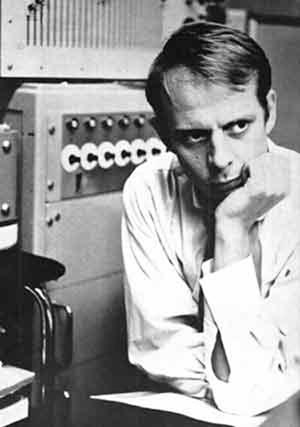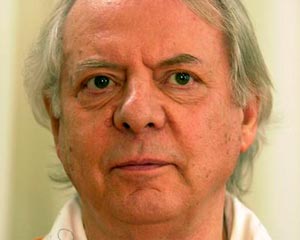
|
Last Kontakte: A Karlheinz Stockhausen Memorial
at the third annual X Avant Festival of New Music |
|
| October 26, 2008 • The Music Gallery • Toronto |
|
|
|
|
|
|
Stockhausen’s Heavy Construction
by Tova G. Kardonne |
|
What do you want from a concert? If you can answer that, I can tell you if LAST KONTAKTE: A Karlheinz Stockhausen Memorial would give it to you. As the finale of the X Avant III Festival of New Music, it promised to provide ‘a wonderful opportunity to get to know’ the work of Stockhausen, with which I was unfamiliar and which, I understand, is nowhere considered mainstream. But it’s virtuosic music, and dramatic, and compelling. It focuses a room’s attention and makes muscles twitch and brings tumbling images before the mind’s eye. The important thing to know walking in, is that you are entering a gallery of modern art. Start with the thing that’s presented, don’t build it in your mind before the musician plays.
The Music Gallery was the perfect venue, last Sunday night October 26th, and the Fellowship Room was full of avid listeners. The program consisted of three pieces: In Freundschaft, for solo soprano saxophone; Klavierstück IX, for solo piano; and Kontakte, for piano, percussion, and electronics.
Wallace Halladay opened the night on saxophone. ‘In Freundschaft’ was almost as much a movement piece as a musical composition. It was helpfully explained before he began that everything, from the rocking motion accompanying the oscillating beeps of sound near the beginning, to the audible breaths, their volume and duration, to the three directions Halladay faced to play from three different ranges of the instrument, and the evident personality and vocabulary each of these ranges assumed, was notated in the score. How can I describe the recurring high-pitched trill… not a theme, for the rest of the sounds were not variations upon it, but more like a home base. There was a honky lower range personality that persistently interjected its two cents, and a wispy, sometimes whiny mid-range call that gave a sense of space and height to the piece. To be clear: no beat, no key, no chorus, no sing-along refrain. The whole thing unfolded without the structure that for many is the enjoyable characteristic of music. So if that’s what you want, never mind. This is something else.
|
|

Karlheinz Stockhausen - 1964 |
|

Karlheinz Stockhausen - 2001 |
|
|
| The second piece, Klavierstück IX, is even more difficult to describe. There was the insistent hammer of repeated clusters, the emphasis shifting between its constituent notes as it fades; there were the long legato lines, almost but not quite melodic, and then the sparse peppering of sounds from the extreme high register counterbalanced against judgments from the basso profundo. Technically, that covers most of what was played. But that is by no means an adequate description of the arc and sweep created by pianist Stephen Drury, nor of the tense embattled contrast between order and disorder that the piece described. A piece so thoroughly sufficient in expression does not want to be translated into words. See? No more words about it.
Time to tackle the final piece, Kontakte.
I wonder how it was made. I mean, I was there, watching it being made, but I still wonder. Aiyun Huang, percussionist, ran incessantly between at least a dozen instruments, flipping pages posted at several locations around the room, while Drury, back for more, also had to leave his post at the keys to bop something or crash something at fairly frequent intervals. The electronic accompaniment — soundtrack? — provided much in the way of continuity. It was well-placed, though, being unabashedly synthetic in sound, never overlapping with the timbres of the other instruments, and exploiting its inhuman manipulations of sound and effect to layer many moods through the piece’s progression. About two thirds of the way through, I was beginning to get a bit shell-shocked by the many short phrases from the piano and percussions. Just as it was beginning to feel like an assault, the phrases elongated and built into a gong-fried climax.
The denouement after that felt natural, which in itself is weird, but I understand that’s what happens after a period inside the acoustic space of Stockhausen’s work. It makes its own kind of sense. Most likely, any two people in the room that night would give wildly different descriptions of the emotional content of any of these pieces. Perhaps the only thing that could be expected to be evident to all was their meticulous construction, their evocative range within a limited acoustic vocabulary, and their raw challenge to the audience, to hear this, now, and feel.
|
|
|
|
|
|



